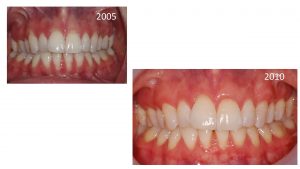
We all want to have the best smile we can, but there are many factors that can take issue to cause it to become flawed. One of these issues that can affect our desire to show off our pearly whites is receding gums. And this is because what most people call gum (gingival) recession is really the visual appearance. In reality, there are a number of underlying factors that lead to the root becoming exposed. In order to have a good, long-term result, all factors need to be diagnosed and addressed. Unfortunately, the visual appearance alone is NEVER a diagnosis. One of the factors that can affect the long-term effect of a graft is whether the teeth are moving outside of the bone. The following case demonstrates one such example:
The patient is a 32-year old female who does not like to smile because of the appearance when she smiles. When the lips are retracted, we get a better understanding of how much recession there is throughout her mouth. In 2005, we successfully reconstructed the tissue that had receded using a minimally invasive approach with connective tissue grafts. The patient did not wear her night guard as recommended to keep her teeth from shifting.
She returned 5 years later because of an increased recession occurring on the front right central incisor. All of the other areas had remained stable except for this tooth. On closer inspection, we get a better understanding of why the one tooth continued to recede. Without the protection of the appliance, the front tooth continued to shift out of the bone, causing the loss of the supporting bone and leading to loss of tissue.
If you find that you are dealing with gum recession, it is important to contact your Chicago dentist as soon as possible to treat this issue.
If you would like more information about gum recession, call Dr. Cabrera in Chicago, IL at 312-994-7939 or visit www.perioimplantchicago.com.
Dr. Cabrera proudly serves Chicago and all surrounding areas.
